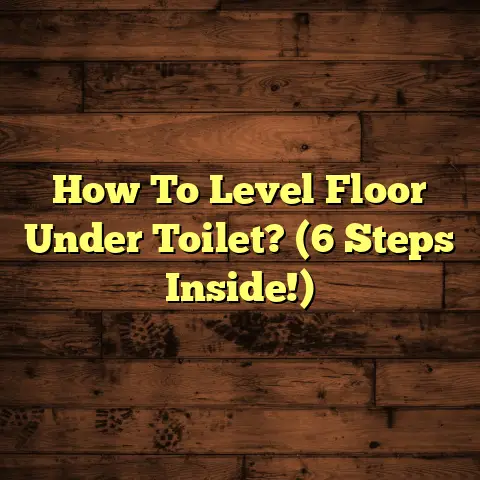Tile Adhesive Calculator? (4 Grout Line Lies!)
I’m guessing you’re here because you’ve stared blankly at a pile of tiles, a bag of adhesive, and wondered, “How much of this stuff do I actually need?”
Trust me, I’ve been there. More times than I care to admit.
Calculating tile adhesive can feel like navigating a minefield. One wrong step, and BOOM! You’re either knee-deep in excess adhesive or making a desperate run to the store mid-project.
The good news? It doesn’t have to be that way.
In this article, I’m going to break down the mysteries of tile adhesive calculation and expose some common myths – especially those sneaky “grout line lies” that can throw your entire project off.
We’ll explore why accuracy is crucial, how a tile adhesive calculator can be your best friend, and how to avoid costly mistakes.
Let’s dive in and get your tiling projects on the right track!
Section 1: Understanding Tile Adhesive
1.1 Definition of Tile Adhesive
So, what is tile adhesive, exactly?
Simply put, it’s the glue that holds your tiles securely in place. It’s the unsung hero of any tiling project, providing the bond that keeps your floors and walls looking fantastic.
But not all adhesives are created equal.
You’ve got a few main types you’ll encounter:
-
Thin-set Mortar: This is the most common type, perfect for most standard tile installations. It’s mixed with water or a latex additive to create a paste-like consistency.
-
Medium-Bed Mortar: This is designed for larger, heavier tiles or uneven surfaces. It allows for a thicker layer of adhesive, providing better support.
-
Epoxy Mortar: This is a two-part system that’s incredibly strong and water-resistant. It’s often used in demanding environments like swimming pools or commercial kitchens.
Choosing the right adhesive is critical.
Using the wrong type can lead to tile failure down the road. Always check the manufacturer’s recommendations for your specific tiles and application.
1.2 Importance of Accurate Adhesive Calculation
Why sweat the small stuff when it comes to adhesive calculation? Because getting it wrong can have serious consequences.
Too much adhesive? You’ll end up with a messy installation, tiles that aren’t flush, and a whole lot of wasted product (and money!).
Too little adhesive? You risk tiles not bonding properly, leading to cracks, loose tiles, and a project that simply won’t last.
I’ve seen it happen firsthand.
A homeowner once tried to save a few bucks by skimping on adhesive. Within a year, their beautiful new bathroom floor was riddled with cracks. The cost of redoing the entire project far outweighed the initial savings.
According to the Tile Council of North America (TCNA), improper mortar coverage is a leading cause of tile installation failures. They recommend a minimum of 80% mortar coverage for dry areas and 95% for wet areas.
That means you need to know how much adhesive to use to achieve that coverage!
Section 2: The Anatomy of a Tile Installation
2.1 Components of Tile Installation
Think of tile installation as a carefully constructed ecosystem. Each component plays a vital role in the overall success.
Here’s a breakdown of the key players:
-
Tiles: The star of the show! Choose the right type, size, and material for your project.
-
Adhesive: The glue that binds everything together. As we discussed, selecting the correct type is crucial.
-
Grout: Fills the spaces between the tiles, providing a finished look and preventing water damage.
-
Backer Board: A stable, water-resistant substrate that provides a solid foundation for your tiles. Cement board is a popular choice.
2.2 The Role of Grout Lines
Grout lines are more than just aesthetic details. They serve several important functions:
-
Accommodation: They allow for slight variations in tile size and shape, preventing stress cracks.
-
Water Resistance: When properly sealed, grout lines prevent water from seeping beneath the tiles and damaging the substrate.
-
Aesthetics: Grout lines define the tile pattern and contribute to the overall look of the installation.
But here’s where things get tricky: grout line width directly impacts the amount of adhesive you need.
Wider grout lines mean less tile surface area to cover, and therefore, potentially less adhesive. However, wider grout lines also change the way the tile lays and is affected by the surface.
Ignoring this factor is one of the biggest mistakes I see DIYers make.
Section 3: The Tile Adhesive Calculator Explained
3.1 What is a Tile Adhesive Calculator?
A tile adhesive calculator is a tool designed to estimate the amount of adhesive you’ll need for your project. It takes into account factors like tile size, grout line width, and the area you’re tiling.
Think of it as a virtual assistant that helps you avoid those costly miscalculations.
There are many free calculators available online. Here’s a typical example of what you’ll find: https://www.calculator.net/tile-calculator.html
3.2 How to Use a Tile Adhesive Calculator
Using a tile adhesive calculator is usually pretty straightforward. Here’s a general step-by-step guide:
-
Measure Your Tiling Area: Determine the length and width of the area you’re tiling. Multiply these numbers to get the total square footage.
-
Enter Tile Dimensions: Input the length and width of your tiles.
-
Specify Grout Line Width: Enter the width of your grout lines. This is crucial for accurate calculations.
-
Select Unit of Measurement: Choose your preferred units (e.g., inches, centimeters, feet).
-
Calculate: Click the “Calculate” button, and the calculator will estimate the amount of adhesive you need.
Example:
Let’s say you’re tiling a bathroom floor that’s 5 feet wide and 8 feet long. You’re using 12×12 inch tiles with 1/4 inch grout lines.
- Tiling Area: 5 ft x 8 ft = 40 sq ft
- Tile Size: 12 inches x 12 inches
- Grout Line Width: 0.25 inches
The calculator will tell you approximately how many bags or containers of adhesive you’ll need to purchase.
Interpreting Results:
Keep in mind that most calculators provide an estimate. It’s always a good idea to add a little extra (5-10%) to account for waste and variations in application.
Section 4: The 4 Grout Line Lies
Okay, let’s get down to the nitty-gritty. These are the sneaky lies that can sabotage your tile adhesive calculations:
4.1 Lie #1: “Grout Line Size Doesn’t Matter”
The Truth: Grout line size absolutely matters!
I can’t stress this enough. As I mentioned earlier, grout lines reduce the amount of tile surface area you need to cover with adhesive.
Ignoring this factor can lead to overestimating your adhesive needs and wasting product.
Think of it this way: If you’re tiling a wall with tiny mosaic tiles and super-wide grout lines, you’ll need significantly less adhesive than if you were using large format tiles with minimal grout lines.
Here’s a simple illustration:
Imagine two identical walls, both 10 square feet.
- Wall A: Tiled with 4×4 inch tiles and 1/8 inch grout lines.
- Wall B: Tiled with 4×4 inch tiles and 1/2 inch grout lines.
Wall B will require less adhesive because the wider grout lines reduce the total tile surface area.
4.2 Lie #2: “All Tile Adhesives are the Same”
The Truth: Different adhesives have different coverage rates.
This is a big one. Not all adhesives are created equal. Some are thicker, some are thinner, and some are designed for specific types of tiles or substrates.
Each adhesive has a coverage rate, which is typically expressed as square feet per bag or gallon. This rate will vary depending on the type of adhesive, the size of your trowel, and the substrate you’re applying it to.
Always check the manufacturer’s specifications for the adhesive you’re using. Don’t assume that one bag will cover the same area as another.
For example, a high-performance modified thin-set might cover 50-60 sq ft per bag, while a standard unmodified thin-set might cover 70-80 sq ft per bag.
4.3 Lie #3: “You Can Estimate Adhesive Needs”
The Truth: Experience helps, but precise calculations are always better.
I’ve been tiling for years, and I still use a calculator to estimate my adhesive needs. Why? Because even with experience, it’s easy to make mistakes.
Human error is a real thing. We tend to overestimate or underestimate based on past experiences, which may not be relevant to the current project.
Plus, every project is different. Tile size, grout line width, substrate, and adhesive type all vary, making it difficult to rely solely on intuition.
According to a study by the National Association of Home Builders (NAHB), inaccurate material estimates are a leading cause of project budget overruns.
Don’t leave your project to chance. Take the time to calculate your adhesive needs accurately.
4.4 Lie #4: “Leftover Adhesive is No Big Deal”
The Truth: Wasted adhesive adds up over time.
Think about it: A bag of high-quality tile adhesive can cost anywhere from $20 to $50. If you consistently overestimate your needs and end up with a half-empty bag that dries out and becomes unusable, you’re literally throwing money away.
Over the course of multiple projects, those wasted bags can add up to a significant expense.
Beyond the financial cost, there’s also the environmental impact to consider. Manufacturing and transporting adhesive requires energy and resources. Reducing waste is a responsible choice.
So, the next time you’re tempted to overestimate your adhesive needs, remember that those “little” leftovers can have a big impact on your wallet and the environment.
Section 5: Real-Life Applications of the Tile Adhesive Calculator
Let’s look at a few real-world examples of how a tile adhesive calculator can save the day.
5.1 Case Study 1: Residential Tiling Project
The Project: A homeowner decided to renovate their kitchen backsplash using subway tiles.
The Challenge: They were unsure how much adhesive to buy, fearing they’d either run out mid-project or end up with a ton of waste.
The Solution: They used an online tile adhesive calculator, inputting the dimensions of their backsplash area, the size of the subway tiles, and their desired grout line width.
The Result: The calculator provided an accurate estimate of the amount of adhesive needed. They purchased the recommended amount and completed the project with minimal waste. They saved money and avoided a stressful trip to the store.
5.2 Case Study 2: Commercial Tiling Project
The Project: A contractor was hired to tile the floor of a large retail store.
The Challenge: The project involved thousands of square feet of tiling, and accurate material estimation was crucial to stay within budget and avoid delays.
The Solution: The contractor used a professional-grade tile adhesive calculator that allowed them to input detailed information about the project, including the type of adhesive, the trowel size, and the substrate.
The Result: The calculator provided a precise estimate of the amount of adhesive needed, taking into account factors like waste and variations in application. The contractor was able to order the exact amount of adhesive required, saving them thousands of dollars in material costs and preventing project delays.
Section 6: Conclusion
So, there you have it! The truth about tile adhesive calculations and those sneaky grout line lies.
Remember, accurate adhesive calculation is essential for a successful tiling project. It saves you money, reduces waste, and ensures a long-lasting, beautiful result.
Don’t fall for the common misconceptions. Use a tile adhesive calculator, pay attention to grout line width, and always check the manufacturer’s specifications for your adhesive.
By following these tips, you’ll be well on your way to becoming a tiling pro!
Now go forth and tile with confidence!





